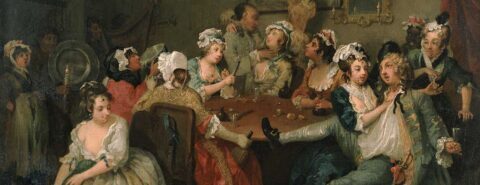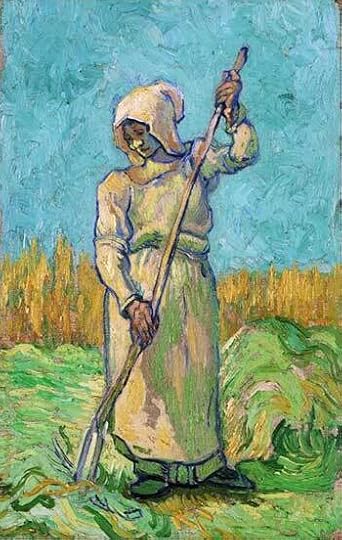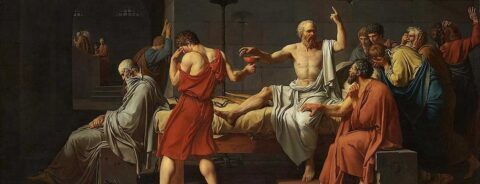Oxford University Press's Blog, page 53
April 15, 2023
Beaumarchais and Electronic Enlightenment

Beaumarchais and Electronic Enlightenment
The addition to Electronic Enlightenment (EE) of nearly 500 letters from the Beaumarchais correspondence is a significant event in eighteenth-century studies. Drawn from the second volume of Gunnar and Mavis von Proschwitz’s edited collection, Beaumarchais and the “Courrier de lÉurope”, first published thirty years ago in Studies on Voltaire and the Eighteenth Century, these letters join with 175 letters from the first volume (previously included in EE). The total of 660 letters in this collection include a combination of letters printed in that periodical and letters from public and private collections. (In 2005, von Proschwitz published a selection of 107 of these in a French edition, entitled Lettres de Combat.)
Collectively the letters being published by EE represent the largest tranche of Beaumarchais letters available for online research; moreover, they constitute approximately one third of Beaumarchais letters published to date and over one sixth of all known Beaumarchais letters in existence.
What makes the Beaumarchais archive significant?In the context of eighteenth-century correspondences, the Beaumarchais archive stands out for several reasons. The first is the volume of the archive. The known portion of the Beaumarchais papers is over 4,500 documents, constituting one of the largest corpora of eighteenth-century papers known. The full archive, if ever fully inventoried and edited, would run somewhere between 6,000 and 20,000 documents. At the upper range it would become among the largest known archives of personal papers of the period.
The second is geographical breadth—from Vienna to Madrid to the Netherlands to England and North America, the Beaumarchais correspondence is important because it shows how actually we limit our understanding if we focus on solely “French” or “Francophone” correspondence networks.
The third is sociological breadth—Beaumarchais as an historical figure offers us insights into the eighteenth century that stand apart from the major figures whose correspondence has been edited and studied. He was an artisan, a musician, a financier, commercial entrepreneur, printer, investor, politician, judge, diplomat, spy, litigant, criminal (he was imprisoned in at least four capitals), husband, lover, brother, father and, of course, a playwright. His correspondence, and thus the network of correspondents connected him to a wider swath of eighteenth-century European and North American society than almost all personal correspondences studied to date, rivaling and perhaps exceeding the Franklin and Jefferson papers in this respect.
Editorial history of the Beaumarchais archiveThe editorial history of the Beaumarchais correspondence extends over two centuries of literary and political history. Since 1809, when the first edition of Beaumarchais’s Oeuvres was published, over 1,500 letters have been edited—though most of them not with the critical apparatus of the Proschwitz letters published by EE—over the course of more than two centuries.
Nearly 500 letters were printed in partial editions of Beamarchais’ work or correspondence, from 1809 to 1929. The first edition of his complete works edited by his amanuensis, Gudin de la Brenellerie (seven volumes, 1809), included 55 letters that Gudin had transcribed. A second edition, by the journalist, historian and politician Saint-Marc de Girardin in 1837 included 53 additional letters. A collection of 29 letters from the Comedie Francaise archives were published in the Revue Retrospective (1836). In his two-volume biography, Beaumarchais et son temps (1858), Louis de Loménie, referenced and included partial transcripts of hundreds of letters, but included in the appendix only 35 complete texts of previously unedited letters. A second biographer, Eugène Lentilhac, in his Beaumarchais et ses oeuvres (1887), included 12 partially transcribed letters not previously published. In 1890, Louis Bonneville de Marsagny published a biography of Beaumarchais’s third (and longest lasting) wife, Marie Thérèse Willermalauz, and claimed to have consulted “sa correspondance inédite” though no letters are reproduced or directly referenced.
In the early twentieth century, the first effort to produce a complete edition of the correspondence was made by Louis Thomas; however, as he explains in the preface to his edition entitled Lettres de Jeunesse (1923), his military service during the Great War put an end to his research; so in 1923 he published 167 letters from the first two decades of Beaumarchais’ adult life, some of which had been previously published. Several years later, in 1929, the eminent French literature scholar in the United States of the day, Gilbert Chinard, edited a collection of Lettres inédites de Beaumarchais consisting of 109 letters acquired by the Clements Library at the University of Michigan; these consisted of letters to his wife and daughter.
In more recent decades, over 1,000 additional items have been published, between the edition launched by Brian Morton in 1968, continued by Donald Spinelli, which added an additional 300 previously unpublished letters over four volumes of Correspondence, and then in 1990, the Proschwitz edition.
Proschwitz, a noted philologist, added to these letters the most extensive critical apparatus associated with any edition of Beaumarchais letters. He did not seek to produce a critical edition or a material bibliography of these letters, approaches that are difficult to apply to eighteenth-century correspondence in general and to the Beaumarchais archive in particular. Rather, Proschwitz in his notes emphasized the significance of these documents for our understanding of Beaumarcahis’ life and of the eighteenth century. In these letters, we see Beaumarchais not only as a playwright seeking to circumvent censorship to have Marriage de Figaro finally staged, but also as an entrepreneur, a printer, an urban property owner, an emissary, and a transatlantic merchant. Through this window we have a window on the eighteenth century that is geographically, socially, and culturally much broader and more diverse than what we generally encounter through the correspondences previously published in EE.
With the appearance of these letters and the launching of the first new projects on Beaumarchais’s correspondence in 50 years, including the effort spearheaded by Linda Gil to produce a definitive inventory with a material bibliography, and my own work to analyze the network of correspondents from the known correspondence, this publication in EE offers eighteenth-century scholars new reason to consider a longstanding, but still little understood, figure of the age.
A version of this blog post was first published on Electronic Enlightenment.
Featured image by Debby Hudson on Unsplash (public domain)
April 14, 2023
Music for Prime Time: 15 of the greatest TV themes

Music for Prime Time: 15 of the greatest TV themes
Music composed for television had, until recently, never been taken seriously by scholars or critics. Catchy TV themes, often for popular weekly series, were fondly remembered but not considered much more culturally significant than commercial jingles. Music for Prime Time is the first serious, journalistic history of music for American television. Jon Burlingame, author of Music for Prime Time and one of the nation’s leading writers on the subject of music for films and television, has selected his favorite TV themes through the years for this playlist.
Listen to his selections for TV’s greatest themes and read on to learn about the composers and their creations.
1. “Peter Gunn” by Henry Mancini (1958)“Peter Gunn” is among the first well-known, widely recognized themes for television. The jazz approach for a suave private detective (who happened to hang out at a jazz club) immediately became the only acceptable music for practically every cop and private eye series (and movies) for the next few decades.
2. “Rawhide” by Dimitri Tiomkin and Ned Washington (1959)Dimitri Tiomkin, who wrote such famous western movie scores as “High Noon” and “Gunfight at the OK Corral,” wrote this cowboy song for a cattle-driving drama for TV starring Clint Eastwood long before he became a movie star. It became one of singer Frankie Laine’s biggest hits and made a fortune for its composer because he insisted on owning the music publishing rights.
3. The Andy Griffith Show theme by Earle Hagen (1960)The best-known and most fondly remembered theme by one of the pioneers of TV music; Hagen would go on to write themes for The Dick Van Dyke Show, I Spy, That Girl, The Mod Squad, and many others. Incidentally, he whistled the tune himself and often said that was the one and only time he ever whistled at a recording session.
4. The Twilight Zone main theme by Marius Constant (1960)The great Bernard Herrmann composed the original theme for Rod Serling’s first season, but it was replaced for season two by this strange tune by an obscure French classical composer—who wasn’t even consulted and didn’t know his musical snippets (written for the CBS music library) were being turned into a TV theme. It has, over time, become musical shorthand for “something weird is happening here.”
5. Jerry Goldsmith TV themes (1961-1995)One of the all-time great Hollywood composers, Jerry Goldsmith started in TV and, while he became an Oscar-winning film composer, he often returned to TV to write themes for old friends who helped start him in the business. In order, they are the spy show The Man from U.N.C.L.E., medical series Dr. Kildare, high-school sitcom Room 222, sci-fi series Star Trek Voyager, homespun period drama The Waltons, and ’70s detective drama Barnaby Jones. Some of these were among the most popular shows of their time.
6. The Addams Family main theme by Vic Mizzy (1964)Vic Mizzy was a funny songwriter who wrote funny comedy themes (“Green Acres” was also his); he came up with the finger-snapping incorporated into the titles of this offbeat half-hour. The show only lasted two seasons, but the theme outlived the original to become a part of the 1990s movies and the ongoing animated series. The harpsichord accompaniment of this theme now resonates in the harpsichord of the Netflix series Wednesday, based on one of the ’60s characters.
7. “Secret Agent Man” from Secret Agent by P.F. Sloan and Steve Barri (1965)This was the first successful rock ‘n’ roll theme for TV (The Beach Boys had done a sitcom theme the year before, but the show was cancelled and the boys never issued a single). Johnny Rivers sang it and it became a top-10 hit on the radio. The show was a British import, and CBS thought it needed a musical update to attract a younger demographic. The guitar hook became the first thing that young guitar players learned to play back in the mid-1960s.
8. “Mission: Impossible” by Lalo Schifrin (1966)Maybe the most famous spy theme ever. Schifrin turned this into a top-40 hit in 1967. It’s one of the reasons there’s now a series of movie thrillers starring Tom Cruise—the theme is so identifiable that it became a marketing tool for Paramount to “sell” viewers on its big-screen franchise. Schifrin became a well-known film composer after that (Dirty Harry, Rush Hour) but this remains his best-known work.
9. “Hawaii Five-0” by Morton Stevens (1968)This was one of the ’60s most dynamic themes, an exciting musical backdrop for a long-running cop show starring Jack Lord. Its original main-title imagery is so iconic that it was largely replicated by the creators of the reboot decades later. And the theme was so crucial to the reboot that composer Brian Tyler made CBS dig out the original arrangement to re-record for the new series.
10. The Persuaders! theme by John Barry (1971)Widely considered among the greatest themes in the history of British television, this hummable waltz-time theme for offbeat percussion instruments was written by the veteran James Bond composer John Barry, whose “Goldfinger” and “Thunderball” were big hits in both the US and UK. The series starred Roger Moore (before he was 007) and movie star Tony Curtis, and it remains a favorite of action-adventure TV buffs of the era.
11. Hill Street Blues theme by Mike Post (1981)Mike Post is responsible for some of the best-known TV themes in history (LA Law, Magnum P.I., The A-Team, The Greatest American Hero, Law & Order) but this is probably my favorite. The Hill Street Blues theme was written for the legendary Steven Bochco series, an ensemble police drama that won many Emmys and remains one of the great cop shows of all time.
12. Dynasty theme by Bill Conti (1981)Along with Dallas, this was one of the top-rated prime-time soaps of its time, a drama about the rich and famous. Bill Conti of Rocky fame composed this very regal theme for the series. He always said that he could never be inspired by the original title, “Oil,” but when they renamed it “Dynasty” this tune came right away.
13. “Where Everybody Knows Your Name” from Cheers by Gary Portnoy and Judy Hart Angelo (1982)This is merely the greatest song about a bar ever written. It’s a sitcom theme, yes, but one that conveys the locale, the people, the mood, and is so catchy and memorable that, decades later, it still resonates. The two-minute version has extra verses and it’s sung by one of the songwriters.
14. Game of Thrones main title by Ramin Djawadi (2011)This theme for the HBO fantasy became a sensation with millions of YouTube—an earworm for cello, tribal drums, and orchestra that introduced us all to a dark and dragon-filled world. The composer won two Emmys for his music, and he redid the main theme for the prequel House of the Dragon.
15. Succession main title theme by Nicholas Britell (2018)A brilliant fusion of classical and hip-hop influences, this Emmy-winning theme by popular composer Nicholas Britell (Moonlight, Andor) serves as a great accompaniment to one of the most popular cable series of our time.
April 13, 2023
What is subject marketing? An interview with Hana Purslow, philosophy marketing manager

What is subject marketing? An interview with Hana Purslow, philosophy marketing manager
In this interview, our marketing manager for philosophy, Hana Purslow, outlines OUP’s approach to subject marketing. She provides examples of campaigns and channels that we use to promote our content and reveals what she enjoys most about her job and how she sees her role evolving in the coming years.
What is subject marketing?Subject marketing promotes a particular topic or subject to a research community by showcasing relevant content in that area, regardless of format. This can include book chapters, journal papers, or articles from our reference products. By marketing the subject, we showcase key content for academics to use in their teaching or research. Through the dissemination of OUP’s scholarly research in this targeted way, we can have a direct and positive impact within the subject community.
Our focus in subject marketing is building our brand and OUP’s profile in a particular discipline. We concentrate our efforts on building a strong subject community around our content; it is only through researchers reading, sharing, and citing our content that we can be sure of the real-world impact our publishing has. Our job in marketing is to ensure that the academic community is aware of OUP’s high-quality, cutting-edge, and impactful research.
I am responsible for leading our philosophy subject marketing. I take huge enjoyment in working with OUP philosophy content and learning from the greatest minds across all areas of philosophy. I find working with OUP Philosophy Editors Peter Momtchiloff, Peter Ohlin, and Lucy Randall extremely rewarding—their knowledge of philosophy is second to none, and with so many interesting areas within the subject to cover, it’s a marketer’s dream when choosing which topics to highlight!
Can you give us an example of a subject marketing campaign you’ve worked on?A good example is the “Philosophy in Focus” campaign I run each month. This is our most successful thematic campaign, where we host a selection of thought-provoking free content around a particular theme. We market this each collection through a range of channels including social media, advertising, email, and a dedicated collection web page—always evaluating our results to hone our strategies for increased reach, awareness, and engagement with our OUP philosophy content.
Our first topic was “race,” which we launched during Black History Month in October 2021. Other topics, which often coincide with observance months, include emotions, disability, feminism, technology and AI, and democracy.
“Through subject marketing, academics can discover our new research in an engaging way, with a topic lens.”
Choosing content around important events or areas in philosophy is a team effort between myself in marketing and my colleagues in editorial, ensuring we share key research within the subject and shine a light on topics that matter. This means that academics can discover our new research in an engaging way, with a topic lens beyond individual titles. Sharing content in a way that engages our audience and showcases the OUP Philosophy brand in the best possible light is something I take great pride in. I am grateful to have so many brilliant authors to work with and feel privileged to share their influential work in campaigns like Philosophy in Focus.
What’s your favourite marketing channel?
The OUPblog—this really helps to increase the discoverability of our content, which is how our books are found on search engines like Google. As we publish across such a broad range of topics, we can get creative when working with authors on blog posts. For instance, in our most read philosophy blog of 2022, Kristin Gjesdal brings a unique viewpoint to the relationship between philosophy and theatre by focusing on the work of playwright Henrik Isben.
Our philosophy blog posts aim to be accessible to non-specialist academics so have a wider reach than our published content itself. We share OUPblog posts widely on social media, particularly through our dedicated philosophy Twitter channel, @OUPPhilosophy.
“We choose channels for promoting our content based on what we want the broader campaign to achieve.”
It’s worth noting that we choose channels for our content based on what we want the broader campaign to achieve, so while not all our campaigns will feature a blog post, this doesn’t make them any less valuable—we align the strategy or channel with the campaign objective.
How and why did you get into marketing?I have always been passionate about marketing, which led to numerous paths in the events, public, and private sectors before joining the publishing industry, which I soon realized was the place for me! Working in marketing for an academic publisher means that I can give back to the world by helping to advance knowledge and learning.
At OUP, we use digital marketing to share high-quality academic content from thought-leading authors around the world. This is something that really drives me; being a lover of all things digital, targeted marketing allows me to build creative strategies that showcase the breadth of publishing we have to offer at OUP, alongside our vision to grow and maximize the impact of our content.
What do you enjoy most about your job?A large part of my role involves working with authors, which is a real highlight for me. I help authors learn how to promote their books by providing guidance and explaining how they can build their profile to increase long-term engagement with their work. Seeing this come to fruition is so rewarding!
Creating campaigns for conferences—such as American Philosophical Association, Philosophy of Science Association, or The Joint Session of the Aristotelian Society and the Mind Association—is another highlight. Whether we’re attending in person or promoting our content digitally, it’s exciting to showcase our cutting-edge publishing with conference delegates and researchers from around the world.
“I help authors learn how to promote their books and build their profile. Seeing this come to fruition is so rewarding!”
Overall, I’m motivated by seeing the impact that marketing can make, from campaign planning right through to the end results. It’s exciting to see how marketing can influence online usage and more, depending on what we’re trying to achieve for that campaign.
How do you see your role changing over the next few years?Everything evolves, and so does my role and offering as a marketer. This will be based on the challenges and opportunities we face in the market—from open access growth to the way people find research, and the ever-changing digital landscape. There is always more to learn, and I am excited to see what’s coming next.
April 12, 2023
A rake’s etymological progress to hell

A rake’s etymological progress to hell
Another punning title! I am so sorry. This post is about a garden instrument, not the profligate, immortalized by William Hogarth and Igor Stravinsky. Last week, I wrote about the verb scratch and promised to discuss the origin of rake. The superficial factor that unites the two words in this blog is the letter in which a reader asked me about their derivation, but as will be seen, there is a deeper link between them. And hell will turn up below more than once, with my good intentions taken for granted.
Three English words sound as rake: the two mentioned above and rake “inclination from the perpendicular” (a sailing term). Though at first sight, they do not seem to be connected, I’ll try to show that their histories perhaps intertwine. Rake “implement” is related to Old Norse reka and German Rechen, a southern word (from rehho). This Rechen has a northern synonym, namely Harke, attested first only in the sixteenth century. Its origin is murky, but rehho and Harke do sound somewhat alike. Rake “profligate” seems to go back to rakehell, that is, a person for whom hell is raked (prepared, made available?), such a compound as puzzles us until we learn its history (think of spendthrift or cocktail).
 William Hogarth (1697-1764). Igor Stravinsky (1882-1971).
William Hogarth (1697-1764). Igor Stravinsky (1882-1971).(Left: self-portrait “The Painter and His Pug” (1745), National Gallery, via Wikimedia Commons (public domain). Right: drawn by Pablo Picasso (1920), Bibliothèque nationale de France, via Wikimedia Commons (public domain))
The sailing term rake is one of several seventeenth-century nautical words of obscure antecedents (like awning and tarpaulin, for example; both have been discussed in this blog). Rake “implement” is related to the verbs meaning “to reach out, stretch, remove,” and it resembles English reach, from raikjan. Then we notice German ragen “to protrude,” most often used with some prefix. A few related forms in Scandinavian also exist. Judging by its Old English cognate, rake, the name of a gardening implement, once began with hr-. And to repeat, an etymologically mysterious synonym (doublet?) of German Rechen “implement” is called Harke. We seem to be dealing with two competing sound groups—rk and hrk—for “rake” and the other words being discussed here. For Harke a sound-imitative origin has been suggested, though cautiously. The others have been traced to the basic meaning “to reach out.”
Writing a blog is different from writing a scholarly article. In a post, one may risk an unsafe hypothesis, listen to a refutation, and, if necessary, recant. I would therefore like to suggest that the initial impulse behind the oldest words mentioned above was to render the noise produced by scratching (this is the link to the scratch–kratzen pair of last week). They came to designate all kinds of objects, including a few protruding ones. After all, a rake is a big, long thing. Reaching out, an angle at which the prow rises above the surface, and so forth, seem, I suspect, to be products of secondary associations.
 Going hrk-rk.
Going hrk-rk.(“Peasant Woman with a Rake (after Millet)” by Vincent van Gogh (1889), via Wikimedia Commons (public domain))
Perhaps the idiom thin as a rake will support my idea. William. B. Lockwood, mainly known for his studies of the origin of bird names, occupied himself one day with raking together the cuttings on the lawn, and a thought occurred to him that there is nothing thin about a rake. (Remember an apple falling on Newton’s head? All dedicated researchers are alike: their problems never leave them in peace.) No one, Lockwood added, says: “thin as a hoe.” Struck by this idea (and it is surprising that it had not occurred to anyone before him), he decided to derive the word in the English idiom from the Old Icelandic root hrak– “wretched, wicked.” I agree that thinness is not a distinctive feature of a rake, but apart from some phonetic difficulties (which I will ignore here), I wonder whether the Scandinavian noun was known widely enough in English to become part of the simile. Lockwood’s supporting material is meager. Also, it might be good to find a similar idiom in a Scandinavian language, but it does not seem to exist anywhere outside English.
Lockwood’s idea, first published in 1973, never lost its appeal to him, and he reproduced it in his 1995 book An Informal Introduction to English Etymology. Philip Durkin, Deputy Chief Editor and the chief etymologist of the Oxford English Dictionary, shared Lockwood’s doubts, but in a 2012 paper, referred to a fact of material culture: “… the implement used by medieval farmers appears to have been rather more similar to the modern soil rake… …perhaps the expression arose from the similarity of a soil rake to the skeletal form of an emaciated figure….” Since the simile was already known to Chaucer, Durkin’s idea looks plausible, and, in an indirect way, it may confirm my suggestion that the old rake, a kind of hoe, did not protrude or stretch, or reach out, but mainly cut-cut-cut, perhaps producing hrk-rk sounds. As Durkin puts it, opinions are likely to continue to differ. But if my hypothesis has any merit, it follows that the names of the objects mentioned above did not go to an ancient root meaning “to heap up, reach out; arrange” or something similar. Such a root may not even have existed.
In an old post, I once told a story of a little girl asking her mother about how the streetcar (tram) functions. The woman explained everything in a most scholarly way. The girl listened patiently and then said: “No, this is not the way it goes.” “And how does it go?” “Ding-dong.” I suspect that the ancient rake went hrk–rk or rk–hrk. Those who will take my musings seriously may also consult the posts on trash and rubbish (24 and 31 March 2021), and those who are interested in the origin of other implements are invited to read the posts for 25 March 2020 (adze) and 14 September 2022 (mattock). Mattocks and rakes belong together, at least to a certain extent.
 A nautical rake.
A nautical rake.(“Bulletin” (1877), United States National Museum, via Flickr (public domain))Topographia infernalis (the end)
“In Sussex the devil is called ‘the poor man’, and the earthworks of the ancient British hill-fortress at the well-known Devil’s Dyke (near Brighton) are known as ‘the Poor Man’s Wall’.” The great Max Müller responded to the author of this note and pointed out that the extraordinary features of nature and even works of art are ascribed to the devil all over the world, for which reason the philologist Herbert Coleridge called the Devil Pontifex Maximus, a pun with an obvious reference to Latin pons, pontis “bridge.” Does anyone know the origin of the phrase poor devil (French pauvre diable, German armer Teufel)? Who coined it and when? Neither thin as rake nor poor devil occurs in my rather complete database featuring the etymology of English idioms. It means that for three centuries no one has discussed them in popular periodicals or scholarly journals.
“The Devil’s Mouth. The term was applied by the Spaniards to the Old Mole battery, whose fire caused them much annoyance when they were besieging the fortress, and the Devil’s Tongue is the point or spit of ground on which the Old Mole battery is built. The Devil’s Tusk is a pinnacle of limestone in the shape of a tooth, and about thirty feet in height, at the rear of the Royal Naval Hospital” [the author did not specify which hospital is meant].
TOPOGRAPHIA INFERNALIS is endless, because the Devil is a famous rake. End of pontificating.
Featured image: William Hogarth, The Tavern scene from “A Rake’s Progress”, Sir John Soane’s Museum, via Wikimedia Commons (public domain)
April 11, 2023
Xenophon’s kinder Socrates

“Of Socrates we have nothing genuine but in the Memorabilia of Xenophon,” Thomas Jefferson wrote to a friend in 1819, comparing Xenophon’s work favourably with the “mysticisms” and “whimsies” of Plato’s dialogues. More recently, many philosophers have taken the opposite view; a typical verdict is that of Terence Irwin in 1974, who described Xenophon as a “retired general” who presented “ordinary conversations.” The idea that Xenophon’s Socratic dialogues entirely lacked the philosophical bite or intellectual depth of Plato’s had become a commonplace in a philosophical discourse which prioritised abstract knowledge over broader ethics.
Both Jefferson and Irwin were right in identifying the characteristics of Xenophon’s depiction of his teacher—his overwhelming concern with providing practical advice for living a good life, and for managing relationships with family and friends. But both missed Xenophon’s lively wit, and his use of the dialogue form to put Socrates in conversation with Athenians, both friends and family and more public figures whose identity adds some spice to the discussion. Xenophon depicts a Socrates who offers pragmatic solutions to the difficulties his Athenian friends face, from Socrates’ own son’s rows with his mother to his friend Crito’s difficulties with vexatious lawsuits targeting his wealth. Where Plato shows Socrates leaving his conversation partners numbed and distressed by their recognition of their ignorance, as if attacked by a stingray, Xenophon takes more care to show how Socrates moved friends and students on from the discomfort of that initial learning moment. He offers practical solutions and friendly encouragement, whether persuading warring brothers to support each other or finding a way in which a friend can support the extended family taking refuge in his home. His advice is underpinned by an ethical commitment to creating and maintaining community.
It is not that Xenophon’s Socrates is afraid to show the over-confident the limits of their capabilities; while he offers encouragement and practical advice on personal and business matters, he rebukes those who want power and prestige without first doing their homework. His Socrates demonstrates to the young Glaucon that he needs to be much better informed about the facts and figures of Athenian civic and military resources before he proposes policy to his fellow citizens in Athens or seeks elected office. Socrates’ forensic uncovering of the young man’s ignorance of practical matters is sharpened for readers who recognise that this is Plato’s brother, depicted in his Republic as an acute interlocutor, able to follow Socrates’ most intellectually demanding arguments. In the conversation Xenophon presents, Glaucon is reduced to mumbling one excuse after another:
“Then first tell us,” said Socrates, “what the city’s land and naval forces are, and then those of our enemies.”
“Frankly,” he said, “I couldn’t tell you that just off the top of my head.”
“Well, if you have some notes of it, please fetch them,” said Socrates. “I would be really glad to hear what they say.”
“Frankly,” he said, “I haven’t yet made any notes either.”
(Memorabilia 3.6.9)
Xenophon might be making a very ordinary claim here, that good leadership decision-making rests on a firm grasp of practical detail. But it gains depth when read against Plato’s argument in the Republic for handing over political leadership to philosopher kings, trained in theoretical disciplines. Xenophon argues that rule should be grounded from the bottom up; he is a firm believer in transferable skills, and that the ability to manage a household might equip someone to lead an army or their city.
Xenophon does not leave Glaucon quite as discomfited as Socrates’ interlocutors in Platonic dialogues become, such as the Euthyphro where the titular character hurries away rather than go through another round of being disabused of his opinions. He shows how Socrates moves on from the low point of the realisation of ignorance and starts to rebuild his interlocutors’ self-confidence, now underpinned by knowledge and self-awareness. Socrates offers Glaucon a careful recommendation for developing his management skills and gaining credibility before returning to public debates as a more impressive contributor. With another student, Euthydemus, Socrates switches from the argumentative mode familiar from Plato’s work—the Socratic “elenchus” or refutation—to exhortation and encouragement, as teacher and student become more familiar with each other and learn together cooperatively.
“Responding to Plato’s dialogues with a less intellectualist account of the capacities that leaders need, Xenophon made a case for the importance of leadership skills and knowledge as the basis of public trust.”
One reason that Xenophon was motivated to show a Socrates who encouraged his students to make useful contributions to public life was to rebut critics who presented him—not entirely without cause—as the teacher of some of the leaders of the brutal regime of the Thirty, which briefly overthrew Athens’ democracy after the end of the Peloponnesian War. Xenophon insists that these former students had abandoned Socrates’ teaching in favour of an aggressive pursuit of power.
Xenophon recognised the usefulness of a wide range of practical experience. A businessman might well make a useful general. But he makes Socrates insist that leaders must show practical knowledge and analytical skills in order to persuade others to follow them and to deliver successful outcomes, whether in business or in battle. The combination of knowledge and skill, which his students label basilikē technē, the “royal art”,” is an essential attribute of leadership. By responding to Plato’s dialogues with a less intellectualist account of the capacities that leaders need, Xenophon made a case for the importance of leadership skills and knowledge as the basis of public trust. In a contemporary context where trust in leaders and educators alike is low, perhaps there is a powerful and accessible case for the role of expertise in government and society, which Xenophon makes through his memories of Socrates’ conversations.
Featured image: “The Death of Socrates” by Jacques-Louis David via The Met (public domain)
April 10, 2023
10 things to know about US immigration policy in the nineteenth century

10 things to know about US immigration policy in the nineteenth century
In the United States today, the federal government controls the admission, exclusion, and removal of immigrants. Yet in the century after the American Revolution, Congress played only a very limited role, setting a policy for naturalization and regulating conditions on board passenger ships. Other than that, the states controlled immigration until the 1870s.
Slavery and its legacies shaped American immigration policy as it moved from the local to the federal level over the course of the nineteenth century. The Civil War removed the political and constitutional obstacles to a national immigration policy. This national policy was first deployed to exclude Chinese laborers with the Supreme Court using Chae Chan Ping v. United States (1889) to lay down the doctrine of plenary power that later provided the foundation of US immigration policy in the twentieth century. The case was invoked as recently as 2018 when the Court upheld President Donald Trump’s travel ban on people from predominantly Muslim countries. Similarly, some of the origins of today’s “crimmigration” system—the nexus between immigration and incarceration—lie in the nineteenth century.
Read on to learn 10 things about US immigration policy in the nineteenth century that give context to some of the immigration concerns we face in the US today.
1. Other than naturalization, the Constitution provided no guidance on immigrationThe Constitution authorizes Congress to establish a uniform rule for naturalizing immigrants as citizens after they have been admitted to the United States. Congress passed a law in 1790 laying down the naturalization system still in place today: citizenship after a probationary period of residence, evidence of good character, and an oath renouncing foreign allegiance. Under this law, an immigrant had to be a “free White person” to be eligible for citizenship. Not until 1870 was the right to naturalize extended to people of African origin. Asian immigrants remained barred from citizenship until the middle of the twentieth century. Strangely for a country that attracted so many immigrants, the Constitution says nothing else about immigration.
2. The states controlled the admission of immigrants until the 1870sIn the absence of a federal policy, the states controlled immigration. America’s borders were not open in the nineteenth century, but neither were they closed the way they are today. States and towns quarantined passengers who carried contagious diseases, and required ship captains to post bonds or pay taxes for foreign paupers and mentally or physically disabled passengers. A small number of immigrants were turned away, but nearly all were admitted. In the 1870s, the Supreme Court ruled that Congress rather than the states had authority over immigration, but admission remained the norm for Europeans until the 1920s.
3. The states regulated the movement of free black people as well as immigrantsIn the South, free black people had to register and carry papers proving their status and their right to residency in the state. Many southern states banned black people from migrating or returning, required formerly enslaved people to leave, and jailed free black sailors – both native-born and foreign-born – for the duration of their stay in port. Territories and states in the Old Northwest (today’s Midwest) also restricted or prohibited the entry of free black people. Male immigrants of European origin, by contrast, could move freely throughout the United States, secure employment, naturalize as citizens, vote, and hold political office.
4. Congress potentially had power over immigration under the commerce clause, but slaveholding states found that power threateningThe commerce clause of the US Constitution gave Congress the power “To regulate Commerce with foreign Nations, and among the several States, and with the Indian Tribes.” But did this power cover migration, both into the United States and between the states? Throughout the antebellum era, the courts skirted around this question rather than confronting it directly.
Shipping companies, resentful of interference in their business, brought court cases against state laws, arguing that these laws violated federal power under the commerce clause. Slaveholders, by contrast, feared that Congressional control over one kind of mobility, immigration, would threaten their power over the mobility of free black people or even the interstate slave trade. If the Supreme Court invalidated a Massachusetts law imposing taxes or bonds on foreign paupers, what would that mean for laws in South Carolina and other southern states jailing free black sailors, or laws in both the North and the South regulating the movement of free black people?
5. The states controlled citizenship as well as immigration policy before the Civil WarBefore the Civil War, towns and states made their own rules for civil and political membership. Country of birth was less important than race or gender in defining who belonged to the community and what privileges they enjoyed. Women were citizens but, if married, were prohibited by coverture laws from owning property, making contracts, and earning wages. Immigrant wives assumed the citizenship status of their husbands automatically after 1855. African Americans were denied citizenship except in the Northeast, where black citizens faced restrictions on voting, holding office, and serving in the militia, as well as residential and educational segregation.
6. The Fourteenth Amendment (1868), by writing the principle of birthright citizenship into the Constitution, provided a powerful mechanism for integrating immigrants and their childrenForged in a war to end slavery, the Fourteenth Amendment extended national citizenship to everyone born or naturalized in the United States and subject to its jurisdiction (i.e., everyone other than children of foreign diplomats, children of soldiers in an invading army, and Native Americans living on tribal lands as members of their own sovereign nations). The American-born children of immigrants, therefore, were citizens at birth—including the children of Chinese immigrants prohibited by law from becoming citizens themselves. By guaranteeing due process and equal protection to every “person” living within the jurisdiction of the United States, the Fourteenth Amendment extended fundamental protections to all immigrants, regardless of whether they had naturalized.
7. The Civil War and Reconstruction marked a turning point in US immigration policyWith eleven slaveholding states absent from the union, Congress began to regulate immigration for the first time during the Civil War, passing an act in 1862 prohibiting American involvement in the transportation of Chinese “coolie” laborers to foreign ports and an act in 1864 giving federal recognition to short-term contracts for the importation of European workers during the wartime emergency. Reconstruction created federally protected rights for all Americans, but it also created a national state capable of regulating immigration much more effectively than the states, with less interference by the courts. Aware of this fact, restrictionists in the American West called on Congress to exclude Chinese laborers.
8. The Chinese were the first targets of federal immigration policy in the postbellum eraThe Page Act (1875), targeting suspected prostitutes, required Chinese women to undergo consular inspection and obtain certificates demonstrating that they were not immigrating for “lewd or immoral purposes.” The Chinese Exclusion Act (1882) barred immigration by Chinese laborers for ten years. Renewed in 1892, this ban remained in place until World War II. The techniques of exclusion, registration, punishment, and deportation deployed against Chinee laborers had precedents in laws policing the internal mobility of free black people in the antebellum South.
9. Federal policy expanded from Chinese exclusion to regulation of immigration more generallyA general immigration act passed in 1882, modeled on the old system of state laws, and designed and implemented by officials from New York and Massachusetts, levied a head tax on all foreign passengers and excluded those likely to become a public charge. A second general immigration act, passed in 1891, shifted the administration of national policy away from the states and toward the federal government and expanded the list of excludable and deportable classes.
10. The Supreme Court ruled that power over immigration was inherent in national sovereignty and assigned that power to the president and CongressIn Chae Chan Ping v. United States (1889), the Supreme Court ruled that the power to control its borders was inherent in the sovereignty of the United States as an independent nation. As a matter of national security, this power lay with the federal legislature and executive and was largely immune from judicial review. In Fong Yue Ting (1893), the Court extended the same power to deportation. This doctrine of plenary power over immigration, inherent in sovereignty and assigned to the “political” branches of government with minimal interference by the courts, placed immigrants in a separate category of law, laying the basis for US immigration policy in the twentieth century.
States and cities today can no longer decide whom to admit, exclude, or deport the way they did before the Civil War. They continue, however, to regulate immigrants’ lives after they arrive in the country. Some states monitor or punish immigrants by restricting access to drivers’ licenses, public benefits, and education, requiring employment verification, penalizing the leasing of property to the undocumented, or prohibiting day laborers from congregating in public spaces. Other states provide sanctuary to immigrants, protect them against discrimination, and assist their integration into society. With Congress gridlocked on immigration reform, long-standing tensions in immigration federalism remain as relevant as ever.
April 5, 2023
Scratching all the way to hell (second series)

Scratching all the way to hell (second series)
Quite some time ago, I was asked about the origin of the verbs scratch and rake. At first sight, the etymology of both looks unproblematic, but modern researchers are cautious people and see reefs where the rest of the speaking community glides happily over the surface. Today, I’ll confine myself to scratch (oh, how hard it was to resist the temptation of saying that I’ll begin from scratch!).
Scratch turned up in English texts only in the fifteenth century. As usual, it does not follow that this verb was coined so late. My doubts are based on the fact that German kratzen (the same meaning) goes back to the oldest texts in that language. Middle English had two synonyms: skratten and cracchen. Cracchen looks French, and William W. Skeat, our greatest but not infallible authority for the origin of English words, believed that scratch and cracchen had been confused, that is, got into each other’s way and produced some sort of semantic blend. Perhaps they did. It is sometimes hard to tell apart even not fully identical twins.
 A magpie, a kind of pie, as Beatrix Potter put it.
A magpie, a kind of pie, as Beatrix Potter put it.© Nigel Brown (CC BY-SA 2.0)
I notice that Swedish skrata means “to make a lot of noise, to laugh uproariously,” while sratta means “magpie.” Both words are rather obviously sound-imitative. To add to this list, Old Icelandic skrati meant “ghost” (a noisy creature?), and its near-doublet skratti was a designation of the Devil; hence English Old Scratch “Devil.” (See some musings on such words in the post for 2 May 2012 “Further Adventures of Scr-Words.”) Scratching does not produce a lot of noise, but the group scr- ~ skr- does occur in quite a few sound-imitative and sound-symbolic words. Scream and screech are ideal examples. Since a bird called “screech-owl” exists, I may mention Swedish skrata “owl” and skratta “to laugh.” (The Germanic verbs for “laugh” were all onomatopoeic: laugh goes back to hlah-; compare hlah– with cluck-cluck and giggle.) English scrape, a verb of Scandinavian origin (Old Icelandic skrapa), makes one think of a jarring sound. Likewise, English scramble may or may not be a loan from Scandinavian, but borrowed or native, it does not refer to peace and quiet.
In dealing with scr– ~ skr– words, one never knows where to look: everything is so suggestive. Is the English adjective scrumptious indeed an emphatic alteration of sumptuous, as some of our sources suggest? This hypothesis is not entirely without merit. Scrimmage is, apparently, a variant or a close relative of skirmish. On the same note: where is scrouge “to crowd out” from? Dickens’s Scrooge, who scrimped and saved, knew well how to screw people and leave them screwed up. The origin of scrimp is also obscure, as it should be. A doublet of skimp? Even Latin scrībere “to write” (consider scribe, script, Scriptures, and others) belongs to our sound-imitative corpus, because writing began as scratching.
 Bull nettle. This pernicious weed looks innocent, even nice, but so do most tempters.
Bull nettle. This pernicious weed looks innocent, even nice, but so do most tempters.By William L. Farr, via Wikimedia Commons (CC BY-SA 4.0)
In any case, scratch and German kratzen seem to belong together, despite the gap in the chronology of their earliest attestations. To my mind, it may not be too bold to assume that even in the oldest period, a pair of synonyms sounding like kratzen ~ scratch coexisted. I even wonder whether the s-form is the later one. When we encounter the enigmatic s-mobile, the ancient prefix that attaches itself like a barnacle to the roots of so many words, we assume that the s-less form is the older one. But perhaps (just perhaps), given the coexistence of a great number of words with and without that spurious prefix, some forms with s- are at least as old as those without it. Kratzen is a verb of murky origin, but if we assume that it began its existence with s and then lost it, rather than that scratch acquired its s later (and developed from cratch to scratch), we may solve the puzzle of their relationship. Be that as it may, we are certainly dealing with sound-imitative and/or sound-symbolic formations.
Topographia infernalisLast week, I promised to continue my series on TOPOGRAPHIA INFERNALIS. Since I did mention the Devil in today’s post, this subject will come in handy. (All the passages below are from Notes and Queries for 1884-85.)
 St. Peter had a key, but did he have a waistcoat?
St. Peter had a key, but did he have a waistcoat?“The Apostle Saint Peter” by Peter Paul Rubens, Museo del Prado, via Wikimedia Commons (public domain)
Five miles beyond hell, where Peter pitched his waistcoat. No one could explain the allusion, and the modern Internet provides no help either. And here is another question that received no answer in the eighteen-eighties: “Is anything known of the origin of the saying ‘Elephant-end,’ which place is supposed to be situated ‘where the devil can’t get for nettles’”? Nettles and thistles are the proverbial food of the Devil. Apparently, the rush belong to his diet too (see below). The Devil, unable to get nourishment, is of course hungry and irate. But why elephant-end,and what does the phrase mean?
“‘An eminent book collector, noted for his good nature, declared that a man who published a book without an index ought to be put into thistles beyond hell, where the devil could not get at him’ (Temple Bar, October 1882, p. 191.) Yet the thistle appears to be in some sense one of the devil’s plants. ‘Having met the Lord one day, the devil asked for oats and buckwheat as his reward for having taken part in the creation of the world. The request was granted, whereupon the devil began to dance for joy. The wolf came up and suddenly asked the meaning of this frivolity. In his confusion, the devil forgot what had been given him, and replied that he was dancing for joy at having received the rush and the thistle, to which plants he still adheres”
(Athenæum, Sept. 23, 1882, review of La Mythologie des Plantes, by Angelo de Gubernatis.) [Temple Bar, 1860-1906, was an excellent literary magazine, and so was Athenæum, 1828-1926. I mainly used the latter for book reviews and letters to the editor, while compiling my bibliography of English etymology and my recently published dictionary of idioms.]
Gudbrand Vigfusson (an anglicized spelling of the name of a great Icelandic lexicographer and philologist) published, in English, the following note in connection with Hekla, the volcano about which I wrote a few lines last week: “In an old Danish hymn or song of the sixteenth century I remember having read of a drove or hunt of condemned souls on the way to Mount Hecla [sic] from Denmark. Satan, the drover, called Lureman [from Danish lure “to lurk”?], sings out: “Come! come! come! you must [that is, you must go] to Heckenfield, to Hecken, to Heckenfield, with the swarm of souls into the black hole…” (The Academy, February 14, 1885). [The Academy, 1869-1902, was another first-rate magazine. One sometimes wonders how in the period 1850-1920 the literate British public could support so many popular journals and consume those thousands of pages every week, and there were many, very many more than the three mentioned here. The Wild Hunt was a story known all over Europe. At one time, in Scandinavia, the god Odin was associated with it.]
In a comment on the previous post, our correspondent wrote that he knew the phrase to go to hell in a handcart (rather than in a handbasket). I think both mean the same, that is, “to go from bad to worse,” and in both, the way of propelling the vehicle remains obscure. Perhaps the driver is Old Scratch.
Reading Between the Lines: Bernard MacLaverty’s Grace Notes and the Peace Process in Northern Ireland

A novel about a female composer struggling with depression after the birth of her child does not, on the face of it, seem to have much to do with war or peace in Northern Ireland. But appearances can be deceiving, as I discovered through researching and writing about Bernard MacLaverty’s novel Grace Notes, which features in a chapter of my book Getting to Good Friday: Literature and the Peace Process in Northern Ireland.
When I reviewed Grace Notes shortly after its 1997 publication, I paid most attention to its themes of female creativity and the relationship between religion and art, and to protagonist Catherine McKenna’s challenges as a lapsed Catholic from Northern Ireland and as a woman in one of the most male-dominated branches of the arts. Though Catherine does not recover her faith, I wrote, she decides that the ends of art and religion are really the same: “communication, communion, between people.”
Working on a commissioned essay about Grace Notes in 2013, I resolved to look more closely at its politics. Other critics had already explored the political implications of Catherine’s music, so I researched events in Northern Ireland while MacLaverty was writing the novel. This exercise revealed that, although Grace Notes was written after paramilitary ceasefires in the summer and autumn of 1994 signalled an important development in the peace process, the two years that elapsed between these ceasefires and September 1996, when MacLaverty sent a complete draft of the novel to his agent, were filled with tension, uncertainty, and scant political progress. The contemporary lack of resolution influenced the form of the book, which has a “happy ending” that occurs, chronologically, halfway through the events depicted in it.
“Grace Notes testifies to the time in which it was written (1994-1996) through its portrayal of strained and broken relationships.”
Set at some unspecified time in the 1980s, Grace Notes does not hint at any foreseeable end to the Troubles, but it testifies to the time in which it was written (1994–1996) through its portrayal of strained and broken relationships and awkward conversations. These personal interactions serve as metaphors for the tense political situation and what would be required to improve it. In my essay on Grace Notes as a “peace process novel,” I focused on scenes in the first half of it depicting Catherine’s return to Northern Ireland for her father’s funeral and her tentative rapprochement with her mother, from whom she has been estranged. I argued that, in this section of his book, MacLaverty offers readers “a subliminal primer on the means of resolving differences.”
Revisiting Grace Notes yet again as I worked on Getting to Good Friday, I examined MacLaverty’s notes and manuscripts, held at the National Library of Ireland in Dublin. Among other things, these revealed his visceral reaction to repeated standoffs between Protestant and unionist Orangemen and law enforcement officials who, in response to protests by residents, attempted to prevent them from parading along a Catholic and nationalist stretch of the Garvaghy Road in Portadown at the height of Northern Ireland’s annual marching season. MacLaverty’s response to this unedifying spectacle, entirely in line with contemporary nationalist opinion, was to deplore “A race of people whose ambition it is to march unimpeded down streets where they are despised.” Even at the time, though, he had enough distance from his own gut feelings to add the note that “Maybe this could be in the novel in the voice of her father.”
In the published version of Grace Notes, MacLaverty transcends his own sectarian resentment to show a positive side of Lambeg drumming, still regarded as a symbol of unionist oppression by many Northern Catholics. Despite her father’s disdain for it, Catherine as a child is “thrilled by the sound, could distinguish the left hand’s rhythm from the right.” Years later, she includes Lambeg drums in her first major symphonic work, Vernicle: a sign of what critics Liam Harte and Michael Parker term her “refusal to be defined solely in terms of her native interpretive community.” Performing the work requires the participation of actual Lambeg drummers, in the shape of “four Orangemen from Portadown.”
“MacLaverty offers readers a memorable illustration of how artists can contribute to the ongoing enterprise of creating a more inclusive sense of Northern Irish identity.”
Grace Notes ends with a vivid description of Vernicle’s premiere, in which Lambeg drums participate to two dramatically different effects. In their first appearance, the drums drown out the other instruments, which try in vain to rise above the “din” as the “black blood of hatred stains every ear.” In the piece’s second movement, the music rebuilds to a climax, at which point “the Lambegs make another entry at maximum volume.” This time, though, the effect “is not one of terror or depression, but the opposite”: “The Lambegs have been stripped of their bigotry and have become pure sound.” Thus, MacLaverty offers readers a memorable illustration of how artists can contribute to the ongoing enterprise of creating a more inclusive sense of Northern Irish identity.
Recent correspondence with Don Carleton, a reader from a Protestant and unionist background, has helped me to appreciate, once more, aspects of Grace Notes I had not fully grasped before. He especially admires the way in which Catherine’s composition achieves “a counterpoint in which people get to make their own tune in a way which creates an overall orchestral harmony” because “Only when we can see each other presented in our own terms and have those terms accepted by other parties can we find reconciliation.”
April 4, 2023
How sustainable is sustainability?

How sustainable is sustainability?
Sustainability in agriculture is a topic of much discussion, particularly as it relates to raising specific livestock such as pigs. But what IS sustainability in agriculture? The United States (US Code Title 7, Section 3103) defines sustainable agriculture as:
an integrated system of plant and animal production practices having a site-specific application that will over the long-term: Satisfy human food and fiber needs; enhance environmental quality and the natural resource base upon which the agriculture economy depends; make the most efficient use of nonrenewable resources and on-farm resources and integrate, where appropriate, natural biological cycles and controls; sustain the economic viability of farm operations; and enhance the quality of life for farmers and society as a whole.
Simplified, sustainability can fit into four areas—environmental, economic, societal, and health/wellbeing.
As described in Vanderohe et al, to reduce environmental impact, the swine industry has used genetic selection (in other words, breeding decisions), enhanced and/or precision nutrition, altered management, and building/mechanical advancements. Breeding for increased feed efficiency and improved maternal behaviors and reproductive traits can increase the amount of product produced with similar or reduced resources.
The environmental impact of swine production has been reduced through precision feeding and dietary strategies to increase feed use and decrease nutrient excretion. Capturing excreted nutrients for further use as fertilizer is an important management strategy, but this requires proper handling and use to prevent unintentional negative environmental impacts. Further, dietary additions such as phytase can result in a more optimal nitrogen to phosphorous ratio in the animal waste, therefore allowing more nutrients to remain in the soil once applied. However, reducing greenhouse gas emissions will require additional changes to manure processing.
Increasing animal growth rates, number of animals, and concentration of swine production can create health challenges. Several viral pathogens pose critical risks to swine production (African swine fever, porcine reproductive and respiratory virus, etc.) due to their devastating consequences to the animal/herd, lack of vaccination and treatment options, and fast transmission between animals. Bacterial pathogens pose different challenges; as we face limited diagnostic tools, rapid pathogenesis of many organisms, increased antibiotic resistance, and decreased public acceptance of antibiotic use. There is a need to focus on controlling stressors to minimize immunosuppression and maximize ability of the animals to resist infection, all while improving biosecurity measures that will continue to protect the animals and workers themselves.
“There’s a need to balance improvements in efficiency and sustainability with societal acceptance.”
The public has added animal welfare to many definitions of sustainability, with three major concerns: physical functioning (animal should be able to function/thrive and not be pushed to mental or physical failure), naturalness (expression of natural behavior of the species), and subjective interactions (the animal can experience positive states, with reduced negative states within its environment). For example, increased public attention in these areas has led to increased pen sizes for various species and contention over the use of farrowing crates for sows. However, there’s a need to balance improvements in efficiency and sustainability with societal acceptance. If an improvement isn’t accepted by consumers, it will not be profitable. For example, the Enviropig, a genetically altered pig which drastically reduced phosphorus excretion (thus lessening the environmental impact) was not ever approved for consumption and received much criticism from the public despite its potential positive impact on nutrient balance.
Changes to management such as larger pen sizes can increase the cost of production while simultaneously reducing the number of animals that can be housed. In general, there are increased costs to the producer to support sustainability. These increased costs require the producer to increase yield or increase product price to remain economically sustainable. However, overall consumer opinions on sustainability and animal welfare are not widely reflected in their consumer behaviors and purchasing decisions.
As we move forward into increasing sustainability in agriculture, it’s important to remember that sustainability in the swine industry is but a piece of a larger puzzle of animal agriculture, which itself is a piece of the large puzzle of global sustainability.

April 3, 2023
How long can the historical associations of places be remembered?

How long can the historical associations of places be remembered?
In Archaeology of Jesus’ Nazareth, I discuss a first-century building in Nazareth probably believed by the end of the seventh century to be where Jesus was brought up. Earlier, Egeria—the Western Roman woman writing in the 380s—says that the house of Mary, mother of Jesus, was on what may be the same site. This raises the question—of much wider applicability than just to first-century Nazareth—of whether local memory of an association between a place and the people who lived there could it really be preserved for more than three centuries.
The answer to this question once seemed clearcut. Sociologists, historians, and social anthropologists such as Maurice Halbwachs and David Henige, working in the late twentieth century, stressed the ways in which the communal recollection of memories could be adapted and altered to fit the current concerns of people in changing circumstances. They doubted that anything historically reliable could persist purely in the shared memories of non-literate people for more than about 200 years.
In terms of religious history, although this has no significant implications for the reliability of the Gospels as historical texts—they were all written well within that c.200-year bracket—it has major implications for the authenticity of those places associated with Gospel passages by fourth-century Christian pilgrims to the Holy Land. When these pilgrims claimed that specific places were the exact locations of particular events in the Gospels, without any written evidence later than the Gospels themselves, one would, according to this “200-year rule,” be inclined to disbelieve these identifications. No association between places and events, it was said, could reliably be remembered simply by word-of-month testimony from the early first to the fourth centuries.
“Can local memory of an association between a place and the people who lived there be preserved for more than three centuries?”
However, twenty-first century studies challenge this twentieth-century scholarly consensus. Several striking instances of correlation between archaeological discoveries and topographical traditions have cast doubt on the existence of a 200-year “historical horizon.” There are so many examples of this that here I can give just a few examples.
Only this year, for instance, a rescue excavation at Leicester cathedral in England confirmed the local story that a Roman temple formerly stood on its site. The present cathedral originated as an eleventh-century church, and no Roman temple in Britain can be shown to have been in use after the early fifth century—so there was an approximately an 700-year gap between the temple and church. Even assuming that Roman ruins discovered during construction of the church in the eleventh century most likely led to the post-medieval legend, the memory of this would have had to have been preserved by the people of Leicester in unwritten form for centuries.
This is nowhere near the longest time that unwritten knowledge seems to have preserved the historical associations of a place. The anthropologists Frances and Howard Morphy have recently drawn attention to scores of inland indigenous Yolngu place-names in Arnhem Land, in the north of Australia, which give details of an earlier coastline identified by twenty-first century geological research and otherwise invisible for about 3000 years. Consequently, there seems no other possible conclusion than that local people, living in the same—but geomorphologically altered—landscape, preserved detailed topographical knowledge of the former coastline over three millennia through their unwritten names for these places alone.
Returning to the Nazareth, a local story recorded in 1881 by the nuns of the Sisters of Nazareth convent said that a big church had once stood on the present Sisters of Nazareth convent site. This place had indeed been the site of a large church, probably razed to the ground by fire in the capture of Nazareth in 1187—694 years earlier. Yet the existence of that church was only discovered during the nun’s subsequent excavations, when they found its ruins buried metres deep below ground-level.
“There seems no doubt that the 200-year rule cannot be taken as the sort of cultural law that it once seemed.”
Of course, by no means all such topographical legends and traditional stories have a basis in fact. Many are certainly no more than fabrication and others contain embellishment or “editing” in later centuries. But judging from archaeological and anthropological cases of this sort of correlation—and the list of them is growing constantly—there seems no doubt that the 200-year rule cannot be taken as the sort of cultural law that it once seemed. While it is impossible to use this to say that the legendary associations of a place always have some basis in historical fact, it may show that they can.
This brings us back to the “house of Jesus.” It is plausible on this basis that the historical associations of a place—even a place in Nazareth—could have been remembered between the early first century and the 380s, or even 670s. But we cannot tell for sure that it was.
Oxford University Press's Blog
- Oxford University Press's profile
- 238 followers



